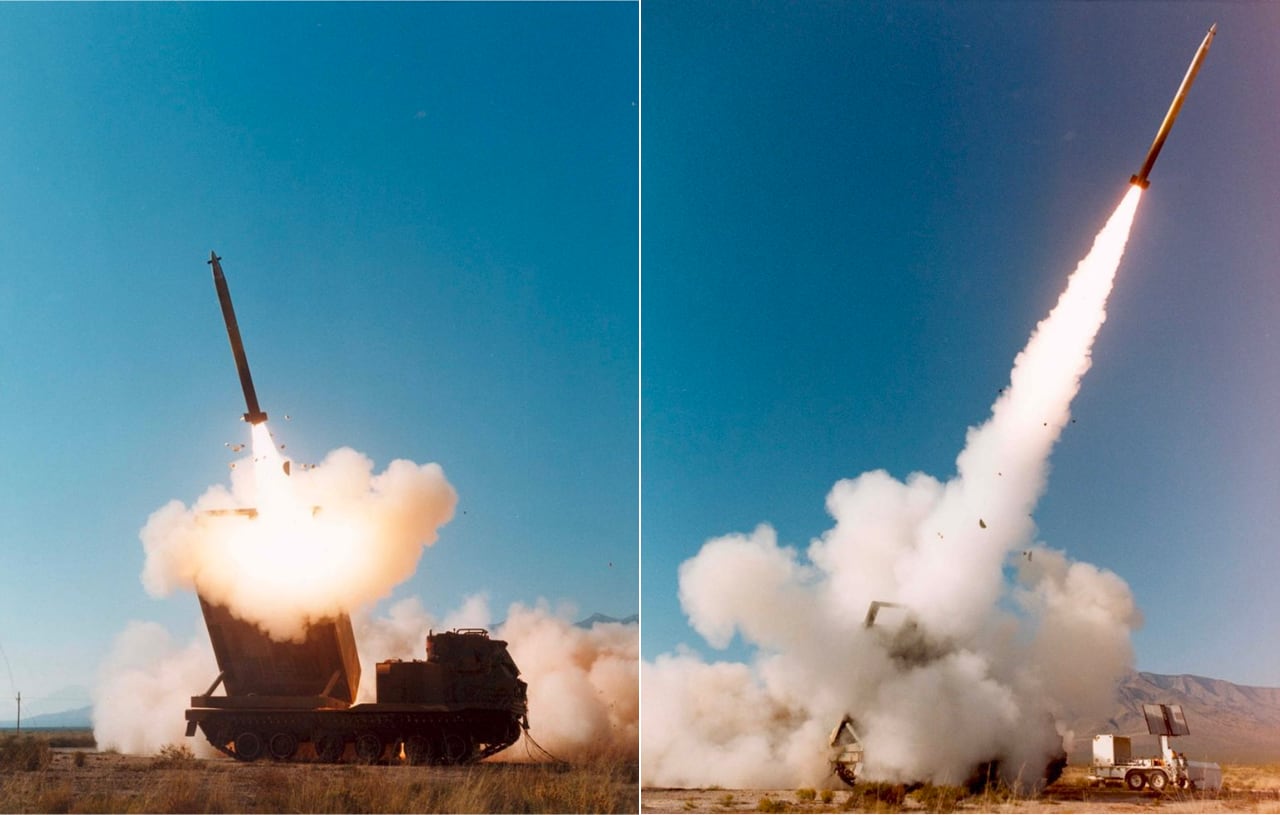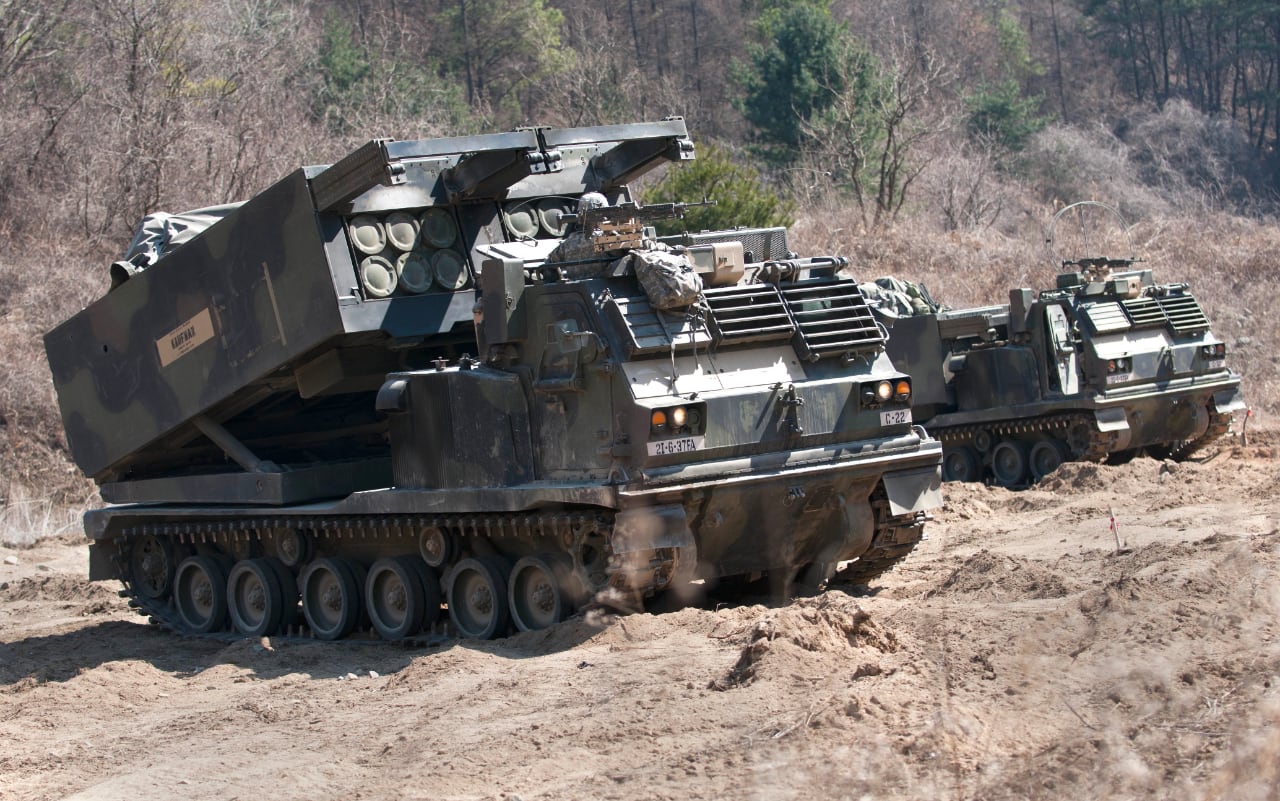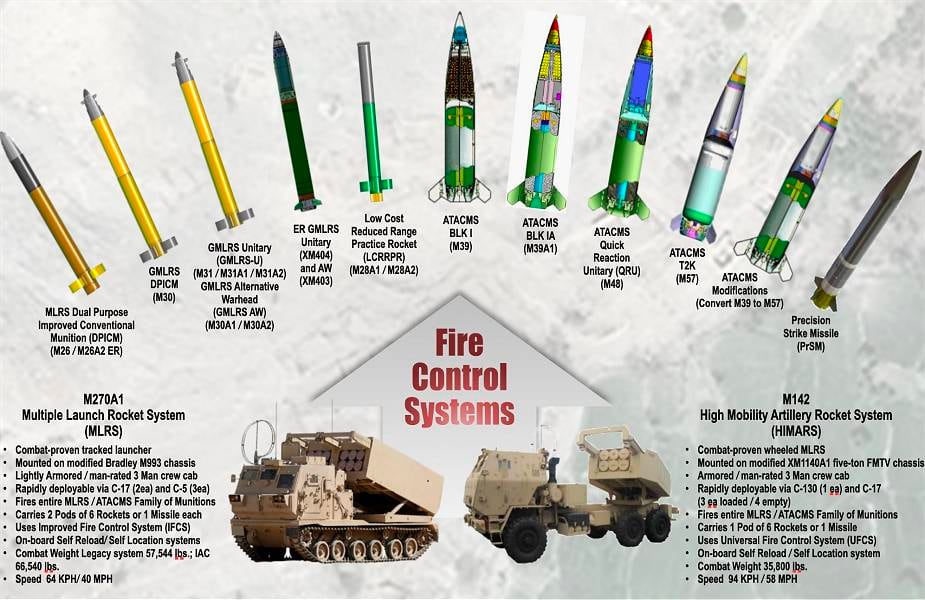Why is there so much talk about the MLRS M270 and M142 HIMARS? We understand why they are important, what missiles are used and how they can change the course of the war
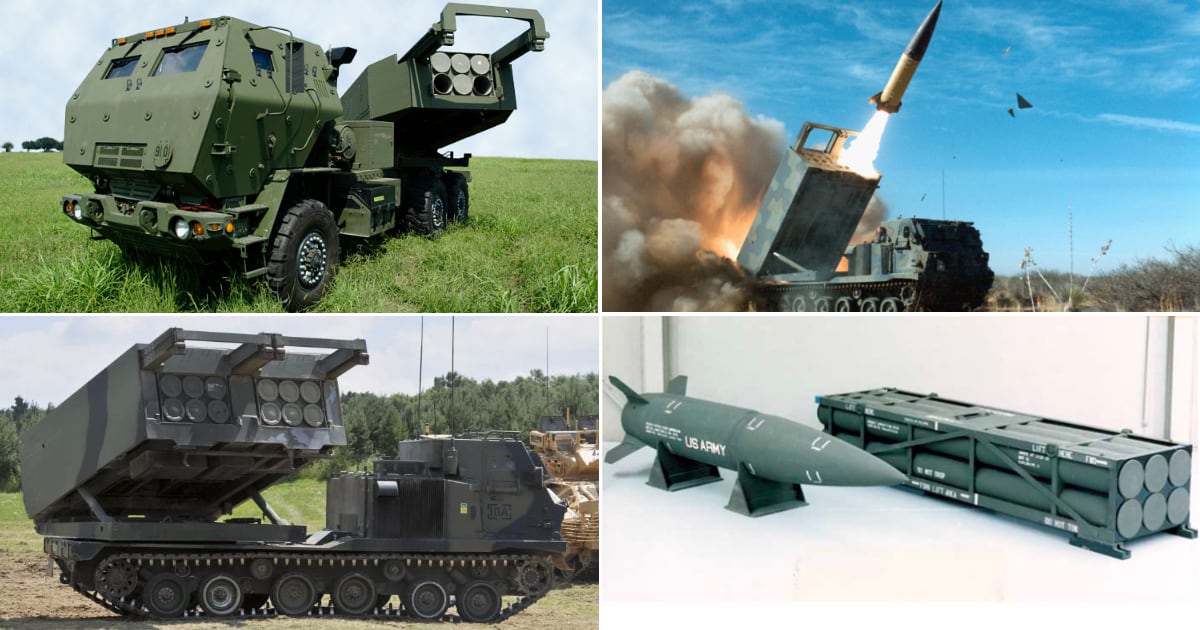
The entire previous week was spent waiting for the delivery of modern multiple launch rocket systems for the Armed Forces of Ukraine. Despite the law on lend-lease, adopted in the United States, according to rumors, politicians feared that this type of weaponry would carry "the risk of escalation if Ukraine strikes deep into Russian territory." But in the end, the US approved these supplies (still - the status of the law obliges them to do this). As a result, the M270 multiple launch rocket systems (on a tracked chassis) and M142 HIMARS (lighter and more mobile, on a wheeled chassis) should enter the Armed Forces of Ukraine, which the US authorities will officially announce next week. Why are these systems interesting, what kind of ammunition do they use, why are politicians afraid of an “escalation” in the conditions of an already ongoing full-scale war (the largest in Europe since the Second World War) and how can they influence the course of hostilities? Editorial gg figured out and ready to share with you.
Content
- What do the abbreviations MLRS M270 and M142 HIMARS mean?
- Place in the history of 227 caliber missiles
- History of MLRS M270
- M270 modifications
- History of the M142 HIMARS MLRS
- Ammunition for M270 and M142 HIMARS: 227mm and 610mm rockets
- 227-mm MFOM rockets for MLRS: guided and unguided
- 610mm long-range precision AFOM/ATACMS missiles
- Fog of war: when will all these MLRS appear on the front lines of the Armed Forces of Ukraine?
What do the abbreviations MLRS and HIMARS mean?
In general, MLRS just means Multiple Launch Rocket System, which is an analogue of the term MLRS (multiple launch rocket systems) that is widely used in our country. Accordingly, MLRS is both an M270 and M142 HIMARS system, since they both belong to the MLRS. In turn, HIMARS (pronounced "Hymars") is an abbreviation for High Mobility Artillery Rocket System - a highly mobile artillery rocket fire system. This name emphasizes two key differences between the M142 HIMARS and the M270 - higher mobility (wheels instead of tracks) and half the firepower (1 standard package that accommodates 6 standard 227 mm caliber missiles or 1 tactical medium-range ATACMS 610 mm caliber missile, instead of 2 for M270).
Place in the history of 227 caliber missiles
To imagine the firepower of 227 caliber, you can compare it with the MLRS that are in service with the Armed Forces of Ukraine today (Wikipedia has interesting pivot table, which compares a huge number of rocket artillery systems). We inherited multiple launch rocket systems from the USSR BM-21 Grad (the modernized Ukrainian version is called Willow ) caliber 122 mm, BM-27 Uragan (Ukrainian developments Bastion-03 and Stormy ) 220 mm and BM-30 Smerch (Ukrainian analogue Alder ) 300 mm. Accordingly, the 227 mm MLRS is closest to the 220 mm systems, but such a comparison is very conditional, because for the M270 and HIMARS missiles are produced by the Lockheed Martin division called Missiles and Fire Control, and among them there are controlled and high-precision. Whereas the Russian and Ukrainian MLRS (especially the old Soviet systems used on both sides of the front) simply do not have guided missiles.
To complete the picture, it is also worth comparing the range of the MLRS 227 mm compared to Soviet systems. As you can see in the infographic, a comparison of the M270 and M142 with Uragan systems will not be in favor of the latter, because the range of 227 mm ammunition starts from 45 km, while the capabilities of Hurricanes are limited to 35 km. Of course, Smerch is capable of hitting targets at a distance of up to 70 km, but the M270 and M142 have an answer to this in the form of the possibility of using high-precision missiles at a distance of up to 300 km (in fact, new generation missiles are capable of hitting targets at a distance of up to 500 km, But more on that later).
That is, the strategy of using MLRS in NATO countries is fundamentally different from the strategy of the remaining Ukrainian and Russian armies from the Soviet Union. The focus is not on gradation by caliber and range of use (and, accordingly, a powerful salvo, up to 40 missiles in the Grad / Verba mount), but on the versatility and mobility of platforms that use a different range of missiles of two calibers used depending on tactical tasks. As well as the accuracy of the defeat, including areas due to cluster munitions. The unification of the nomenclature, among other things, allows you to save resources on maintenance of equipment, logistics, and so on, which is of great importance for modern warfare. That is, only two MLRS platforms - M270 and M142 replace almost the entire zoo of rocket artillery inherited from the Soviet Union, ranging from three types of MLRS to numerous types of tactical missiles (Dot, Oka ) and new Iskanders. Each such system requires its own infrastructure in the form of launchers, command and transport-loading vehicles, further complicating the situation with repairs in the field.
History of MLRS M270
In the early 1970s, the Soviet Union had a clear advantage in rocket artillery over NATO forces. The Soviet MLRS tactic was to bombard with large numbers of truck-mounted multiple rocket launchers (primarily the BM-21 Grad). Saturating the war zone with thousands of missiles and ensuring that only a few of them will hit specific targets, having an additional psychological effect on enemy soldiers. In contrast, US gunners have traditionally favored cannon artillery, due to its relative accuracy and savings in ammunition, over rockets for "area fire".
The situation in the perception of this type of weapons changed after the 1973 Yom Kippur War in Israel, where the MLRS showed good effectiveness. Back in the second half of the 1960s, the US Army Missile Forces initiated a program to create a multiple launch rocket and artillery system with the militant name MARS (Multiple Artillery Rocket System). In March 1974, the US Army created new requirements for the development of a rocket launcher called the General Support Rocket System (GSRS). It was assumed that it would be used to combat enemy air defenses and for counter-battery fire, freeing artillery units for direct support of ground forces. At the beginning of 1980, the development program was renamed and received the name by which we know it now, that is, MLRS. At this stage, the military departments and companies of the military industry of Great Britain, Germany and France joined it, as a result, 4 states had a hand in the development of the M270 in one way or another.
The M270 MLRS weapon system is also known under the general name SPLL (Self-Propelled Loading / Launcher - Self-propelled loading and launcher). SPLL consists of three main subsystems mounted on one machine: M269 LLM (Loader Launcher Module - a loading and launching module, which also contains an electronic fire control system installed on the M993 transport vehicle, which, in turn, is a derivative of the chassis BMP Bradley.
According to the doctrine of the cold war, the tactics of using the M270 was that the vehicles were to covertly disperse individually, then, at the right time, move to a firing position, launch missiles, and then immediately withdraw to a reload point, and then move to a new hidden position, from which to exit to the next firing range. This tactic shoot and scoot “shoot and run” (in theory) avoided vulnerability to Soviet counter-battery fire. A full salvo of the M270, consisting of twelve 227 mm M26 rockets, hit 7728 anti-personnel submunitions (bomblets) on an area of 24 hectares in less than one minute. And one MLRS battery (9 installations), firing 108 missiles, had firepower equivalent to 33 cannon artillery battalions.
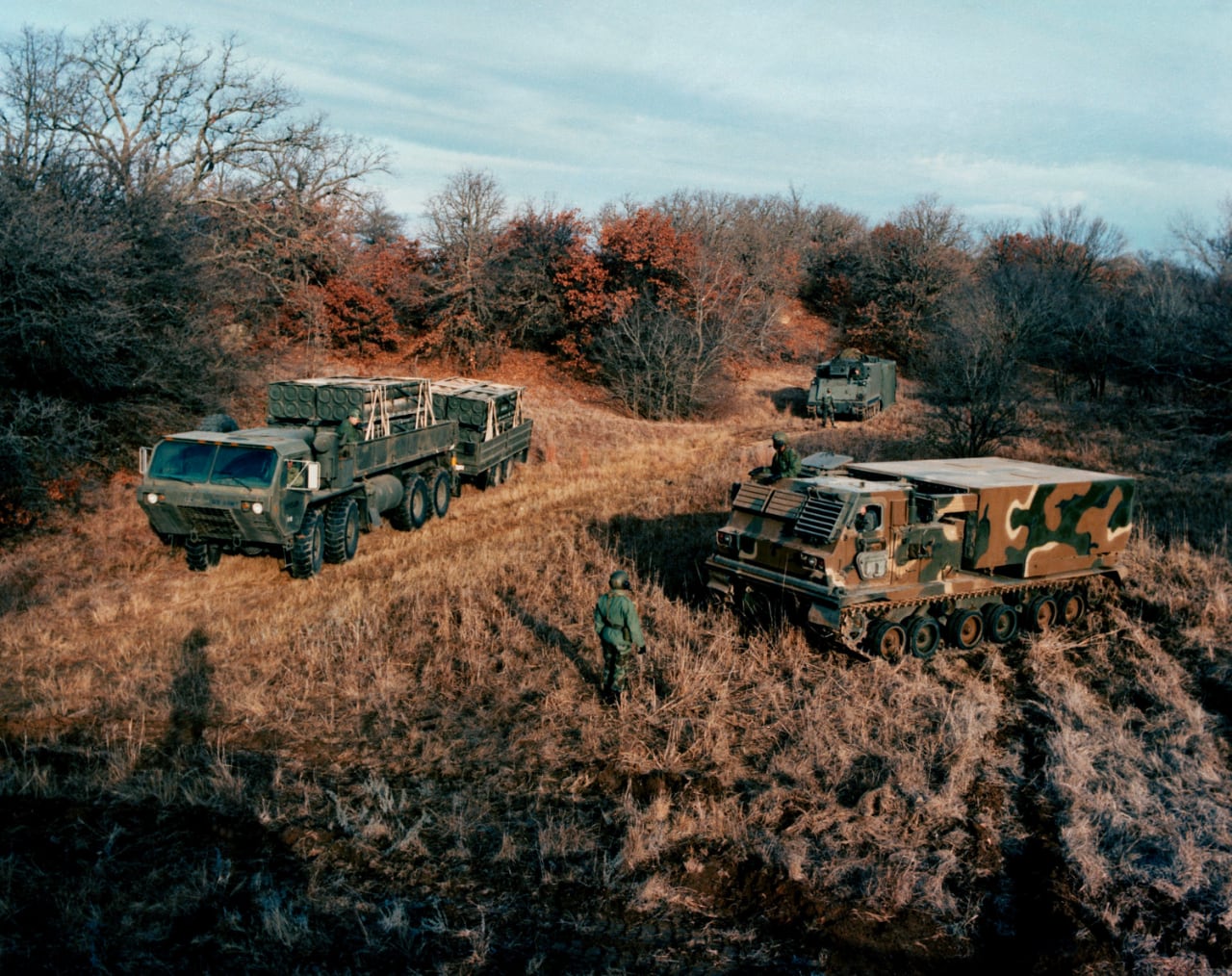
A photo: M270 system with missile transport module, launcher and command center inside the command vehicle M577 (on the background) (Wikipedia )
An important advantage of this system is the launcher, which allows you to quickly reload both launch containers using your own winch (in the video below).
The first combat use of the M270, put into service in 1982, occurred on January 18, 1991, during Operation Desert Storm, when the M270 battery fired eight ATACMS missiles at Iraqi air defenses. In one engagement, three MLRS batteries fired 287 missiles at 24 separate targets in less than five minutes, which would have taken an artillery battalion to fire over an hour. In early February 1991, the largest night firing of MLRS in history took place: 312 missiles were fired in one volley. Of the 57,000 artillery rounds fired in that war, 6,000 were MLRS rockets and another 32 were ATACMS missiles.
M270 modifications
For more than 40 years of history, the M270 MLRS has undergone several upgrades and modifications for different countries. The current version in production is the M270A2 (third generation with a range of up to 500 km using PrSM missiles).
- M270 - the initial version of the MLRS of the 1982 model, a combat load of 12 missiles in two six-seat launch containers. This armored tracked mobile launcher uses a Bradley chassis and is highly cross-country.
- M270 IPDS - An interim update designed to allow the use of long-range GPS-enabled ATACMS Block IA missiles until a sufficient number of M270A1 launchers are produced.
- M270A1 - the first major modernization in 2005 for the US Army (and then for a number of other states). The launcher received an improved fire control system. This made it possible to significantly speed up the firing of new types of ammunition, including GPS-guided guided missiles.
- M270B1 is an upgrade for the British Army, similar to the A1, but additionally includes a reinforced armor package to better protect the crew from terrorist improvised explosive devices.
- M270C1 - An upgrade option proposed by Lockheed Martin using a universal fire control system like HIMARS (UFCS) instead of IFCS.
- MARS2/LRU - European modernization of the M270 with the participation of Germany, Italy and France. MARS2 is equipped with another European Fire Control System (EFCS) developed by Airbus Defense and Space. EFCS allows M31, M31A1, M32, AT2 and 110mm missiles to be fired but not M26, M26A1 and M30 to ensure full compliance conventions on cluster munitions, which was ratified by the EU countries (unlike, for example, Ukraine and Russia).
- M270D1 - includes a new fire control system that allows you to launch high-precision GPS-guided missiles - GMLRS and ATACMS. The upgrade package consists of a new computer, location device, GPS antenna, launch control unit, displays, and remote control. Current operators include the US, UK, Bahrain and Finland.
For those who want to know more
- The M270 crew consists of 3 people: installation commander, gunner and driver
- Aircraft can be used to transport the M270 Boeing C-17 and Lockheed C-5
- Reload time is 4 minutes for M270 and 3 minutes for M270A1
- Powerplant: Cummins VTA903 V8 diesel turbocharged 500 hp
- Maximum highway speed: 64 km/h
- Power reserve: 480 km
- The average cost of the M270 is 2.3 million dollars
- In total, more than 1,300 M270s were produced, of which about 1,000 are in service with the United States.
- The US military refers to the M270 as the "commander's personal shotgun" or "buckshot on the battlefield". It is also often referred to as the "gypsy van" because crews store additional equipment (camouflage nets, cots, refrigerators, and personal items) on top of the vehicle, as there is not enough space in the launcher itself for items.
History of the M142 HIMARS MLRS
The M142 HIMARS is a lightweight (wheeled) version of the M270 multiple launch rocket system. HIMARS uses the same unified container pod as the M270, accommodating six 122mm rockets or one 610mm rocket. The only difference is that the M270 uses two of these canisters, allowing for a salvo of 12 missiles rather than 6. The system was developed in the late 1990s for the US Army and is mounted on the chassis of a standard M1140 army truck. Adopted in 2003, it was the first unit of the US Marine Corps to receive it.
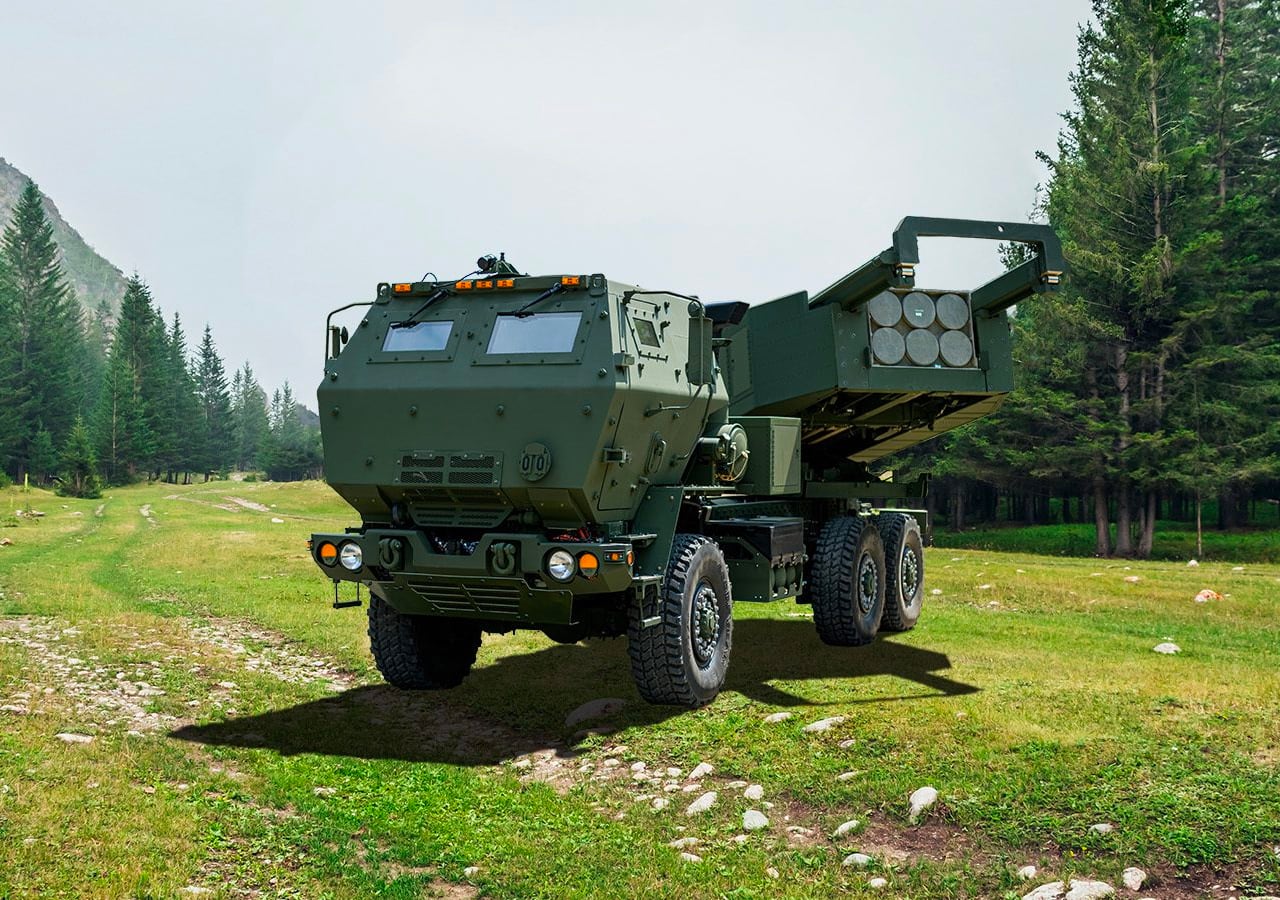
The chassis was originally manufactured by BAE Systems Mobility & Protection Systems. In 2010, Oshkosh Corporation took over chassis production. Since 2017, both the chassis, the launcher and the missiles have been manufactured by Lockheed Martin Missiles & Fire Control. MLRS M142 HIMARS is in service with the armies of the United States, Singapore, UAE, Jordan and Romania. Poland announced plans to buy 160 M142 launchers for use on its own chassis (although on May 26, 2022, the Minister of Defense announced already about 500 installations). Interest in this MLRS has been announced in recent years by Australia, Taiwan, Canada, Hungary, the Netherlands, Qatar, the Philippines and Sweden.
For those who want to know more
- The windows of the M142 HIMARS launcher are made of glass and layers of sapphire
- Aircraft can be used for transportation C-130 Hercules (the most massive transport aircraft in the world)
- The cost of the HIMARS launcher and all necessary ammunition is more than $ 5 million
- The M142 HIMARS crew consists of 3 people: crew commander, driver and launcher operator
- Speed up to 85 km/h
- Power reserve 480 km
- More than 540 units produced with more than 2 million operating hours
Ammunition for M270 and M142 HIMARS: 227mm and 610mm rockets
For the MLRS M270 and M142 HIMARS, there are as many as 6 types of missiles, including a training RRPR (Reduced-Range Practice Rocket), which is just a blank without a warhead and a fairing with a range of 15 kilometers. The remaining missiles are divided into 2 large subclasses: MFOM (MLRS Family of Munitions - MLRS family of ammunition) caliber 227 mm and 610 mm AFOM (Army TACMS Family of Munitions - a family of ammunition ATACMS, which, in turn, stands for Army TACtical Missile System, that is, the Army Tactical Missile System).
227 mm rockets MFOM for MLRS: managed and unmanaged
If we do not take into account the RRPR training rocket, then all 227-mm rockets for the MLRS (or MLRS, to make it clear that we are talking only about the systems to which this text is devoted) are divided into unguided (the most massive and cheapest in production) and guided . Guided missiles, in turn, are divided into two categories: GMLRS (Guided MLRS, that is, guided MLRS) and ER GMLRS (Extended-Range GMLRS - extended-range guided missiles).
- M26 - unguided rocket category DPICM (Dual-Purpose Improved Conventional Munitions - dual-purpose cluster munition) with 644 M77 submunitions. Its range is 32 km. It is worth noting here that this is the same non-conventional weapon, banned, for example, in the European Union, but used by the US army. One of the results of using such missiles is the abundance of remaining unexploded submunitions, the disposal of which after the war will require enormous resources (plus civilian casualties are inevitable even after the war).
- M26A1 - extended range missile up to 45 km and 518 M85 submunitions (improved version of M77 submunitions)
- M26A2 - A transitional version of the M26A1, but with M77 submunitions. Used before the M85 submunition entered service.
- M27 - a completely inert training container, created for LLM loading training by the MLRS crew
- M28 - a training version of the M26 missile, which uses containers with ballast and smoke marking instead of a payload
- M28A1 - version of the M28 without a fairing and with a reduced range (the same RRPR).
Guided MLRS missiles are next
- M30 - the basic and most massive modification of a high-precision missile with a range of up to 70 km, the standard charge includes 404 M85 submunitions. With its advent, the M270 and M142 MLRS HIMARS were nicknamed the "70-kilometer sniper rifle."
- M30A1 - version of the M30 with an alternative warhead, in which submunitions are replaced by tungsten balls for destruction. Its advantage is that it does not leave behind unexploded ordnance.
- M30A2 (also known as XM403) - version of the M30 with an alternative high-explosive fragmentation warhead carrying 90 kg of submunitions and a high explosive. Designed to hit targets with a large area.
- M31 - a derivative of the M30 missile with a unitary high-explosive fragmentation warhead weighing 90 kg for use in urban and mountainous areas. Has improved modifications M31A1 and M31A2.
In March 2021 Lockheed Martin introduced a new generation of guided missiles for the MLRS M270 and M142 HIMARS - ER GMLRS (Extended-Range GMLRS). They are distinguished by an increased range of up to 150 kilometers and unpretentiousness to weather conditions. There is little information about the new missile, the manufacturer reports that it is compatible with the HIMARS MLRS and the latest M270A2. Together with the rocket, a new unified container for MLRS was introduced, allowing the use of 10-inch caliber rockets (254 mm instead of the current 227 mm).
610mm long-range precision AFOM/ATACMS missiles
Instead of six 227mm rockets in a standard MLRS container, one large 610mm ATACMS (aka MGM-140) rocket can be used. This is a surface-to-surface missile with a solid-propellant engine and a flight range of up to 310 km. Its development began back in 1980, and the first combat use was during Operation Desert Storm in 1991, where 32 such missiles were successfully used.
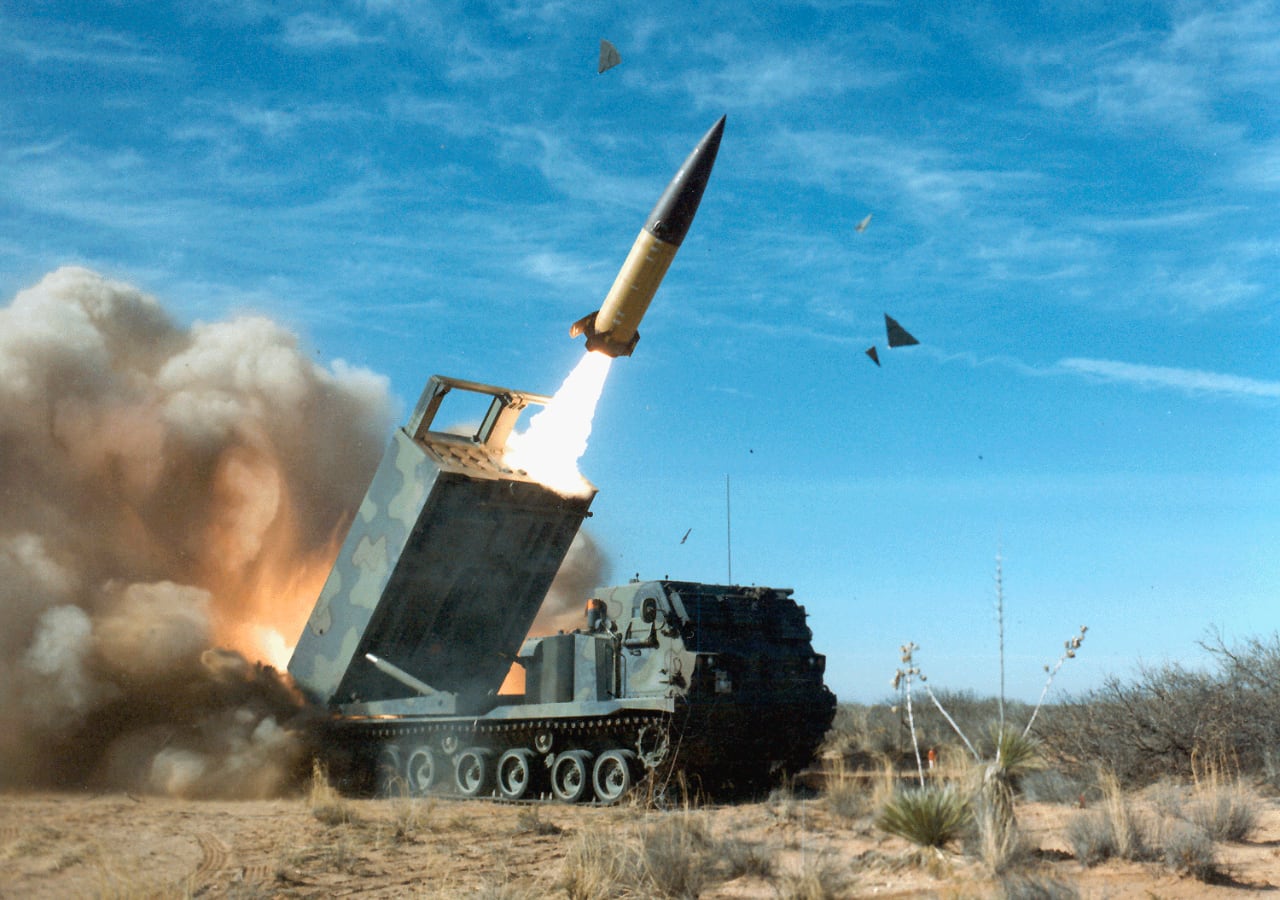
Over the more than 30-year history of this rocket, it has received several levels of modernization and modifications:
- MGM-140A ATACMS Block 1 - the basic version of the 1991 model rocket with a firing range of 165 km and an inertial navigation system that gives a CEP (circular deviation) at 250 meters. The warhead contained a cassette filled with 950 M74-type submunitions.
- MGM-140B ATACMS Block 1A - An upgraded modification in which the inertial navigation system was supplemented with GPS, which made it possible to reduce the CEP to 100 meters while increasing the flight range to 300 km. The cassette warhead has been reduced from 560 to 160 kg and contains 275 M74 submunitions.
- MGM-140B ATACMS Block 1A Unitary - modification of the Block 1A missile with a high-explosive warhead and a vertical end section of the trajectory for hitting armored targets.
- MGM-140C / MGM-164A ATACMS Block 2 - a missile with a warhead, including 13 homing submunitions. The firing range is 140 km with a warhead weight of 165 kg and a KVO of 200 meters.
- MGM-164B ATACMS Block 2A - a version of the missile that did not go into mass production, equipped with a cluster warhead with 6 homing intelligent warheads, as well as a new combined homing head that searches for a target in the millimeter-wave radio wave and two infrared ranges. Firing range up to 220 km with CVO less than 100 meters.
- MGM-140E ATACMS Block 1A Unitary (QRU) / MGM-168A ATACMS Block 4A - modification of the ATACMS missile with a WDU-18 high-explosive fragmentation warhead weighing 227 kg, a firing range of up to 270 km and a CEP of 20 meters. Adopted in 2003.
Precision Strike Missile (PrSM): the latest high-precision missiles for MLRS
Precision Strike Missile (PrSM) is a precision missile Lockheed Martin next generation ground-to-ground class completed in 2021. It features an open system architecture, is modular for future growth, and is compatible with the HIMARS and M270 MLRS. This missile is capable of hitting targets at a distance of up to 500 kilometers. It is unpretentious to weather conditions and takes up half the space than the ATACMS missile, which makes it possible to place not one, but two such missiles in a standard container for MLRS.
Fog of war or when will all these MLRS appear on the front line of the Armed Forces of Ukraine?
So, we figured out what is the advantage of the MLRS M270 and M142 HIMARS over similar systems in service with Ukraine and Russia. These are versatile platforms ideal for shoot-and-run tactics that are advantageous in modern warfare. Superior to the old Soviet (and their modernized counterparts) in efficiency due to the use of guided and precision-guided munitions (and their diverse range, solving specific tactical tasks in the best way). At the same time, they have a much larger range than the enemy's MLRS. Finally, the possibility of using tactical missiles ATACMS can significantly increase the range of missile weapons of the Armed Forces of Ukraine, increasing this distance from 120 km (the capabilities of the most "long-range weapon of the Armed Forces of Ukraine - the Tochka-U missile") to 300 km (and in the future - up to 500 km). The versatility of the M270 and M142 is capable of transforming them from our familiar multiple launch rocket systems into high-precision tactical missiles in one fell swoop. Yes, the cost of one such missile can easily go for a million dollars, but here the law on lend-lease comes to the rescue, according to which you won’t have to pay for used ammunition, in principle (from which Russian propagandists who talk about what kind of lend-lease more than one generation of Ukrainians will have to pay, it starts to burn like a tank after getting to know the FGM-148 Javelin).
Thus, the question comes to the fore: when will all these excellent systems not only get to Ukraine, but will already be used on the front line? The answer lies in the intricate intricacies of politics and military stratagem, which are best described by the saying (no matter how cynical it may sound now) "war is bullshit, the main thing is maneuvers." We, of course, do not mean its literal, but allegorical meaning. Let's consider two diametrically opposite situations: ideally winning and ideally losing. In the first case, politicians and the military do everything as transparently and clearly as possible, involving the media and demonstrating how, when, how much and what kind of equipment arrived in Ukraine (and by what routes). Everything happens immediately and live. In the second case, on the contrary, politicians and the military avoid specifics, constantly refer to the need to decide something else, agree on and discuss it, delaying the issue of supplies indefinitely. Obviously, both options are beneficial only for our opponent. Because in the first case, he will know too much, which will allow him to take some countermeasures. Ultimately, this will only delay the approach of final victory. In the second case, we are talking about a psychological defeat (and therefore the forces of enemy propaganda are aimed precisely at convincing us of the reality of the scenario in which Ukraine will not receive any MLRS M270 and M142 HIMARS).
Obviously, the correct option for supplies and their “highlighting” by official sources will be some kind of intermediate one. And here the “fog of war” comes to our aid, allowing us to use informational smoke screens around the situation. For example, to officially announce the intentions of deliveries only after the weapons are already physically located in Ukraine (at least in order not to expose the convoys to unnecessary risks). You can also hide the quantity, range of ammunition supplied, and in general, the less information you give, the better. An excellent example of such smoke screens are, for example, statements by the Pentagon that smoke the situation around the supply of MLRS: on the one hand, there is “escalation concern”, on the other hand, “we would not want to limit the Armed Forces in the use of weapons to protect sovereignty.” How to interpret it? “No one knows that,” as the classic said. Another example: the Minister of Defense of Poland the other day tweetedthat his country intends to buy 500 M142 HIMARS launchers. Despite the fact that from 2005 to 2020 they were produced in total 414 pieces. Why does Poland need more M142 installations than the United States has? "I don't know anyone." But it is reliably known that this month US President Biden visited Lockheed Martin factory. Specifically, that plant does not produce missiles for the M270 and M142, but FGM-148 Javelin anti-tank systems, but the President of the United States cannot visit each of the 11 Lockheed Martin Missiles and Fire Control plants, right? His visit is just symbolic. For example, it demonstrates to the whole world that Lockheed Martin needs to increase the production of its missiles. And as soon as possible.
In fact, most military analysts are inclined to think that at the current stage of the war, the only thing in which Russia has an important advantage over the Armed Forces of Ukraine is the number of cannon and rocket artillery (and ammunition for them). That is why the supply of 155 mm artillery systems to Ukraine is so important (the same Caesar, M109 and M777). The supply of jet systems MLRS M270 and M142 HIMARS will further increase the capabilities of the Armed Forces of Ukraine, especially in terms of range. And even if Ukraine does not receive missiles like ATACMS and even more so PrSM immediately (and most likely it will), then after weeks (the more complex the equipment, the more time the Armed Forces need to master it) we will already see the result of using these MLRS in the news . Recall, after all, that two months ago the delivery of Harpoon anti-ship missiles looked like an unattainable goal, and today they Oleksiy Reznikov: Ukraine has already received M109 self-propelled guns and Harpoon anti-ship missiles. With MLRS M270 and M142 HIMARS everything will be the same, but faster.
For those who want to know more
- WSJ: US approves deliveries of MLRS and HIMARS long-range multiple rocket launchers to Ukraine
- Unsurpassed weapons: Ukrainian kamikaze drones (loitering munition) ST-35 Grom and RAM
- ️NASAMS anti-aircraft complex and Harpoon cruise missile: what Zelensky asked the Norwegian parliament
- Oleksiy Reznikov: Ukraine has already received M109 self-propelled guns and Harpoon anti-ship missiles
- Switchblade kamikaze drones: what kind of weapon is it and what is it capable of (video)


